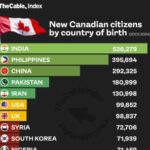Japa: See The Numbers of Thousands of Nigerians that Obtained Canadian Citizenship In Two Decades
Japa: See The Numbers of Thousands of Nigerians that Obtained Canadian Citizenship In Two Decades

Japa
Over 71,000 Nigerians Became Canadian Citizens in Two Decades

According to Immigration, Refugees, and Citizenship Canada (IRCC), over 71,459 Nigerians have acquired Canadian citizenship between 2005 and 2024.

Countries statistics
IRCC, a Canadian government department, handles immigration, refugee matters, and citizenship. Nigeria ranks 10th in the number of new Canadian citizens by country of birth.
The IRCC data reveals that new Canadians come from 196 countries and territories, with the top 10 countries accounting for nearly half of all new citizens, showcasing the diversity of Canada’s citizenry.
Political sociologist and migration expert Irene Bloemraad told CTVNews that high levels of citizenship correlate with better economic outcomes. “Canada stands out among immigrant-receiving countries with high citizenship levels, which lead to better economic outcomes, a greater sense of belonging, and the ability to participate in elections and policy-making,” Bloemraad said.
Since 2005, India has been the leading source of new Canadian citizens, with 536,279 individuals. The Philippines follows with 395,694 new citizens, and China ranks third with 292,325. Other significant contributors include Pakistan (180,999), Iran (130,998), the United States (99,652), the United Kingdom (98,837), Syria (72,706), South Korea (71,939), and Nigeria (71,459).
Al Parsai, a Toronto-based immigration consultant, highlighted that the data reflects Canada’s commitment to multiculturalism and diversity. “The consistent number of new citizens from countries like India and the Philippines underscores their significant contributions to the Canadian labor market and society,” Parsai noted. He also pointed out that the rise in new citizens from conflict-affected countries like Syria showcases Canada’s role in providing refuge and support.
In November 2023, Canada announced a new immigration-level plan targeting the admission of 485,000 new immigrants in 2024. The plan includes skilled workers, caregivers, families, and other classes. By 2025 and 2026, Canada aims to welcome 500,000 new immigrants each year, focusing on economic, family, refugee, and humanitarian classes.
TRENDING SONGS
 Wedding Called Off: How Lady Cancels Wedding After Finding Out Finance’s Affairs With Her Bestie
Wedding Called Off: How Lady Cancels Wedding After Finding Out Finance’s Affairs With Her Bestie
 Heartbreak in Ikeja: Lady Weeps After Fufu Found in New Phone Package
Heartbreak in Ikeja: Lady Weeps After Fufu Found in New Phone Package
 Twist of Fate: Man Who Questioned Phyna’s ₦1Billion Demand Mourns Brother in Dangote Truck Crash
Twist of Fate: Man Who Questioned Phyna’s ₦1Billion Demand Mourns Brother in Dangote Truck Crash
 Tragedy in Enugu: Dangote Truck Claims Lives of Family of Five
Tragedy in Enugu: Dangote Truck Claims Lives of Family of Five
 Bangkok Crackdown: Nigerian-Thai Couple in Police Net Over Drug Trafficking
Bangkok Crackdown: Nigerian-Thai Couple in Police Net Over Drug Trafficking
 Family Rift: Reno Omokri’s Ex-Wife Says He Deserted Their Special Needs Son
Family Rift: Reno Omokri’s Ex-Wife Says He Deserted Their Special Needs Son
 The Man Who Sent Money for Two Decades, Only to Return to an Empty Shell
The Man Who Sent Money for Two Decades, Only to Return to an Empty Shell
 See how a young lady was beaten in a village and naked for stealing a goat
See how a young lady was beaten in a village and naked for stealing a goat
 See How Man That Plans to Divorce His Wife, Gets Shocked When She Leaves Him First With Their 5 Kids
See How Man That Plans to Divorce His Wife, Gets Shocked When She Leaves Him First With Their 5 Kids
 Tragic Land Dispute: Man Kills Father in Imo, Pastor Arrested for Rape
Tragic Land Dispute: Man Kills Father in Imo, Pastor Arrested for Rape
Share this post with your friends on ![]()













